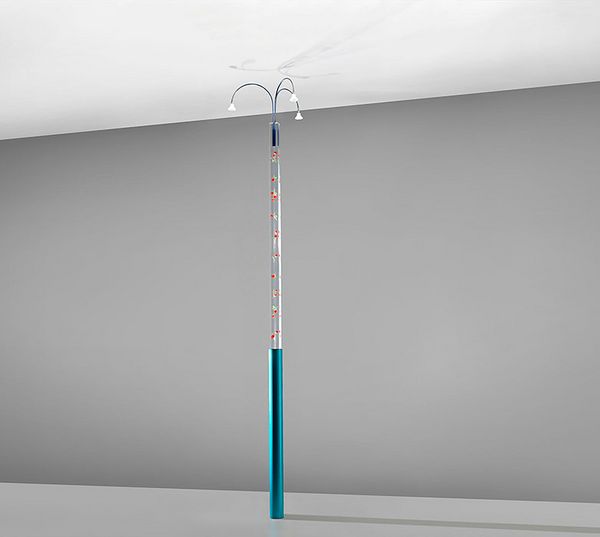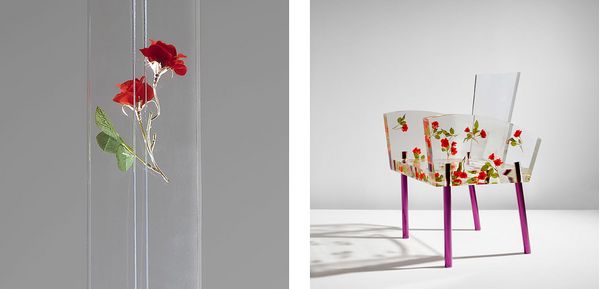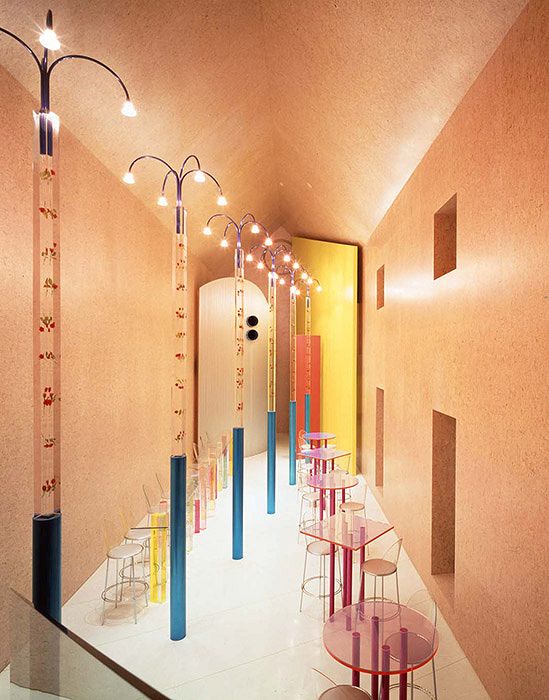Shiro Kuramata, Unique monumental floor lamp, from Oblomov restaurant, Fukuoka, Japan, 1989. Design London.
I like transient, momentary things… I like the tension of something that will only happen once, that will soon disappear.
– Shiro Kuramata
Paradoxically immortalizing a fleeting moment in time through the illusionary defiance of gravity, Shiro Kuramata’s Unique monumental floor lamp showcases a rare and incremental application of the fabrication technique to encapsulate florals in acrylic, which the designer had perfected just the year prior in his renowned Miss Blanche chairs. As in the chairs, the imaginative construction of cast acrylic with objects inside exemplifies the designer’s creative ability to dynamically combine light and form in curious ways within his pieces.
Left: Detail of the present lot, Shiro Kuramata, Unique monumental floor lamp, from Oblomov restaurant, Fukuoka, Japan, 1989. Right: Shiro Kuramata, 'Miss Blanche' chair, designed 1988, executed before 1991. Sold by Phillips, New York, 7 June 2022, for $516,600.
The brilliance behind the method to enrobe florals in acrylic lies in its contradictory nature: the sense of natural effortlessness evoked by the piece conceals the extensive effort to physically produce the effect. Deyan Sudjic summarizes the laborious process in the catalogue raisonné for the designer: “Working by trial and error, the team hit on a method of pouring acrylic to half the depth of the mold, putting in the flowers, waiting eight hours for the acrylic to go hard, then pouring in the rest to the top of the mold, and waiting another eight hours. In the early stages, the roses needed to be held in position with tweezers until the resin hardened sufficiently to ensure that they did not sink to the bottom of the mould. Allegedly, the procedure was interrupted at regular intervals by Kuramata telephoning the workshop to check on progress.” The anecdote provides insight into the designer’s keen awareness and ability to control new materials for unprecedented applications, as well as his devout commitment to the entire fabrication process.
While the employment of artificial florals and playful colors may initially obscure the lofty and sophisticated philosophical notions conveyed in this piece, two overarching aspirations central to Kuramata’s oeuvre are achieved by the whimsical roses suspended within the columnar acrylic forms: the desire to eliminate gravity, and the aim to perpetually preserve a chance moment in time. His pursuit to convey intellectual concepts through inventive formal expressions of newly developed materials provided inspiration for a generation of Japanese designers that followed.
This visually light and effervescent lamp, one of a series of seven similar pieces, was part of Kuramata’s designed interior for the Oblomov restaurant and vodka bar within the Il Palazzo hotel in Fukuoka, Japan. Oblomov, like many of the hundreds of bars, clubs, and restaurants Kuramata designed throughout his career, featured rhythmically repetitive, minimalistic forms made from industrial materials such as aluminum, acrylics, and glass or steel mesh presented in sleek and sumptuous, modern finishes that highlight his artistry through innovative fabrication. The vodka bar, with its chipboard walls and gold leaf trim, created a dialogue using the strong contrast between the ordinary and the opulent. The lamp’s unexpectedly colorful anodization and meticulously suspended artificial florals inspires thematic discourse on the subjectivity of luxury via the transformative act of artistic intervention upon industrial materials.
A picture of the present Unique monumental floor lamp, in Oblomov restaurant, at Hotel Il Palazzo, Fukuoka, Japan, 1989. Photo: © Mitsumasa Fujitsuka.
As a founding member of the Memphis Group of postmodern designers, the influence of Shiro Kuramata’s participation in the style is still apparent in his work after the formal movement ended in his continued use of commercial, industrial materials and bright colors. Unexpected, yet delightful alchemical fabrications using contemporary industrial materials made readily available by the concurrent rapid economic growth in Japan demonstrate why Ettore Sottsass Jr., his collaborator and friend, expressed an inability to dichotomize Kuramata’s work as singularly ‘art’ or ‘design’.
Discover More from Design London >
Recommended Reading
The Emergence of the Master: Ettore Sotsass >
A Masterpiece of Brazilian Modern Design >
Antiquity Made Modern: Diego Giacometti >
Elevation of the Human Spirit through Postmodern Design: Alessandro Mendini >


